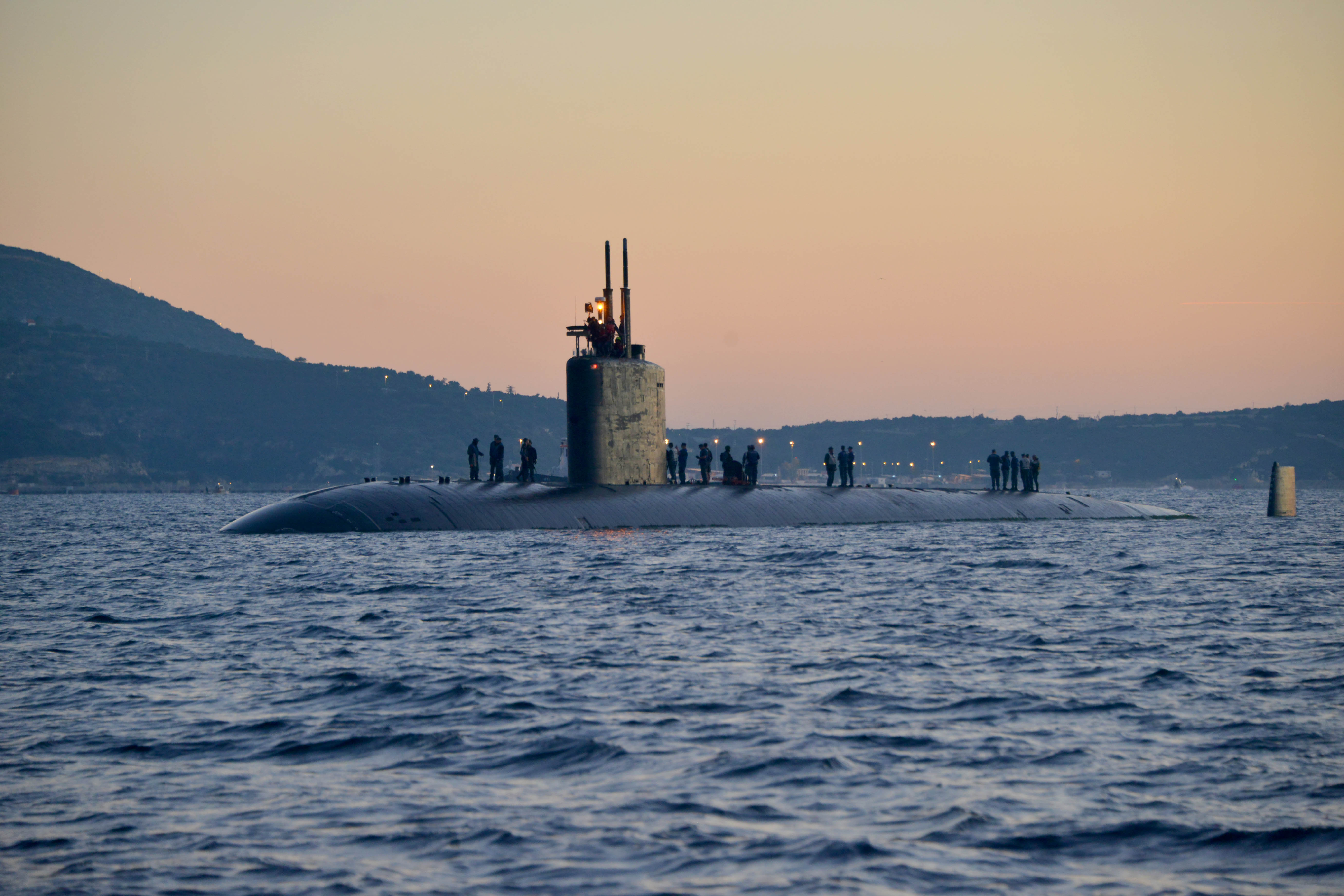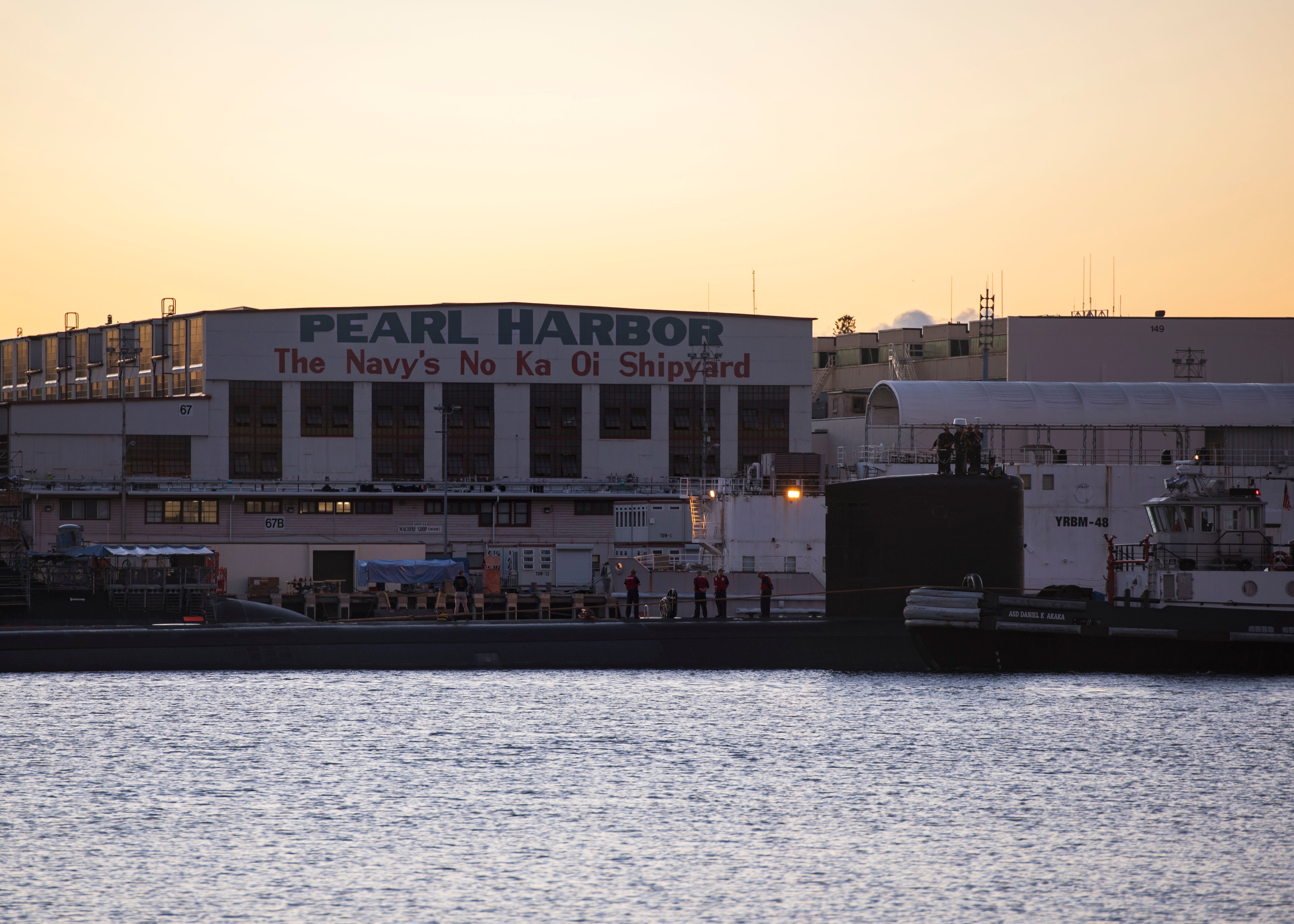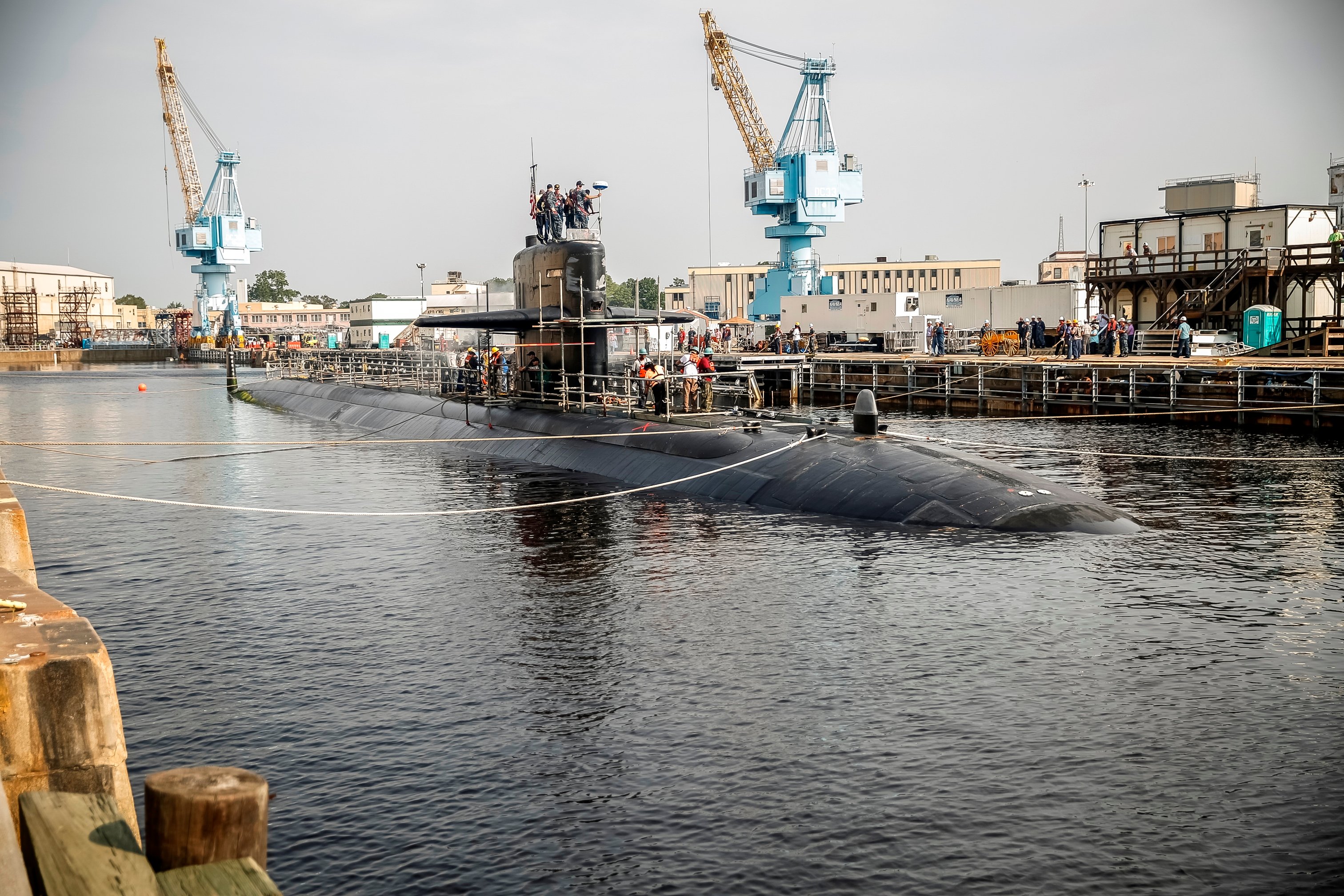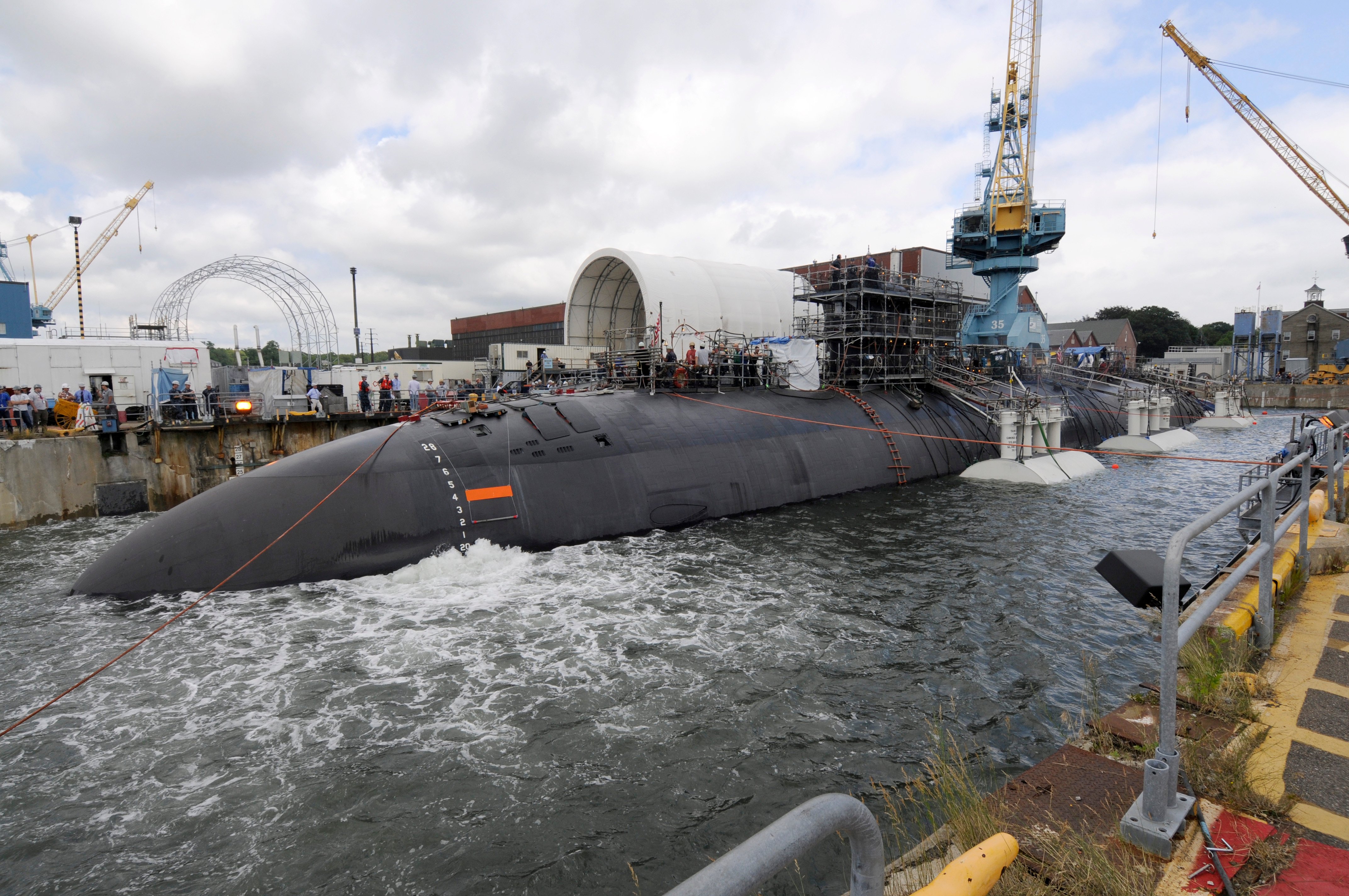
WASHINGTON, D.C. – The Navy and submarine builder Newport News Shipbuilding are committed to having a private industry submarine repair capacity for the long-haul, even if the first recent forays into the effort resulted in long delays and cost overruns.
The Navy’s own ability to maintain its attack submarines has been strained in recent years, as the four public naval shipyards are overwhelmed with work on the Ohio-class ballistic missile submarines and the Nimitz-class aircraft carriers, with Los Angeles- and Virginia-class attack subs being the lowest priority work. These SSNs have often seen delayed inductions or delays once in the shipyard due to the workforce being tied up with higher-priority availabilities. As a result, the Navy a couple of years ago tried to send some of this work out to industry – both Huntington Ingalls Industries’ Newport News Shipbuilding yard in Virginia and the General Dynamics Electric Boat yard in Connecticut – but ultimately those two yards saw their own delays and cost-overruns with USS Helena (SSN-725) and USS Montpelier (SSN-765), respectively.
Navy leaders at a Senate hearing last week couched the problem as one of basic workforce skill and program management that arose as the private yards tried to reconstitute an in-house repair capability. But a Newport News official told USNI News that many of the challenges arose when the yard tried to take on repair work without the same benefits of lessons learned and advanced planning that the public yards have access to. Both sides, however, are committed to doing better and hope to continue performing submarine maintenance at Newport News for years to come.
Vice Adm. Tom Moore, commander of Naval Sea Systems Command, told USNI News last week after a Senate Armed Services Committee that delays with Helena had led to delays in the ongoing USS Columbus (SSN-762) availability at Newport News now and the expected upcoming availability of USS Boise (SSN-764) there in 2020.
“I think what we’re trying to do at Newport News is to help them … establish a workforce, to regain some proficiency, get better at the planning. We’ve actually offered up resources from the public shipyards to go down and help them, from a lead maintenance activity perspective and project management perspective,” Moore said when asked about the status of and the cause of the delays, which Moore first acknowledged one and a half years ago.
“There’s some basic fundamental blocking and tackling that they’ve got to get better at, and I think they recognize that. We would like to keep them in the submarine maintenance business for the long-haul for a number of reasons: it’s a surge volume for the public shipyards, and it’s also, if we go to war we’d like to have that capacity.”

Moore added that Newport News is “getting better. We’re close to delivering Helena, expect to get that out here probably in the February timeframe. Columbus will be undocking probably sometime in the late spring or early summer, and then we’ll get Boise in there as well. So they’re making improvements. We’d certainly like to see the pace of that increase, and we’re working pretty closely with them because we need them to be successful.”
A Newport News Shipbuilding official, who spoke to USNI News on condition of not being named, said the company has extensive experience with submarines – through pairing with Electric Boat to build all the Navy’s subs – and with repair work – conducting aircraft carrier mid-life overhauls at the shipyard and sending personnel to repair yards and bases around the world to work on carriers and subs. Doing submarine repair work at the shipyard, though, is something that hasn’t been done since about 2009.
“We did reconstitute a workforce and facilities here in the yard to pick up some of the submarine maintenance where the naval shipyards found themselves with a heavy workload,” the official said.
“We did stand that team up pretty rapidly and picked up Helena. Subsequent to Helena, which we’re looking to complete early next year, we have the Columbus in the yard, and that’s an [engineered overhaul]. So we have been fortunate to have really great support from the Navy on their experiences in submarine fleet support and maintenance. We’ve had good communications and had solid teamwork on opportunities to learn from one another and continuously improve, and they’ve shared a lot with us and we’ve shared a lot in return to try to provide the best outcome possible for all of us, for the Navy, for the nation, to get these boats back out in the fleet where we all want them.”

Much of that sharing, though, didn’t start until after Helena was in the yard and overran its docking selected restricted availability that was set to last five-and-a-half to six months. The sub arrived at Newport News in October 2017 and should have been done by about April 2018. Instead, Helena is still being worked on today and is expected to come out of the yard around February 2020, nearly two years late.
The Newport News Shipbuilding official said the company has deep experience in hiring and training the right personnel, investing in the right facilities and tools and managing programs to be successful; similarly, the government/industry team has long ago learned the lessons that contracting and planning have to be done early, and materials have to be on hand at the beginning of the work period to be successful.
And yet, Newport News did not have access to the right information for early planning or materials acquisition ahead of starting Helena in the same way that the four public yards would have, setting up a difficult first-in-a-decade private sub repair.
For example, the public yards have a “contingent material list” of items that should be kept on hand in case they are needed. This covers items not in the official work scope but that have arisen in past maintenance availabilities often enough that it’s common knowledge within the Navy that the materials should be on hand so as to avoid delays if emergent work arises. The NNS official said the company did not have that list before Helena was inducted into its docking availability, leading to some delays as the company had to pause while material was ordered and eventually delivered.
Similarly, Columbus began work in July 2017 and was supposed to be completed in August 2019. Instead, Moore predicted that the sub would be undocked and returned to the fleet in April 2020.
Private repair yards on the surface ship maintenance side have experienced similar issues, complaining that the Navy has access to more information on ship conditions and work scope than the yards do. That information can’t always be shared due to rules related to competitively contracting out the maintenance work, but the Navy and the private yards have worked diligently recently to find ways to award contracts earlier, conduct more thorough planning earlier, assemble better materials lists, and other steps to ensure better outcomes: chiefly, on-time and on-budget deliveries back to the fleet. Those lessons could likely be applied to private companies bidding for submarine repair work to see similar improvements in performance.
The Newport News Shipbuilding official said the shipyard learned a lot about expected and emergent work, as well as expected and emergent testing, that will be required for future work on Los Angeles-class SSNs. These lessons learned the hard way, plus information shared by the Navy in recent months, should set the yard up for greater success in upcoming availabilities, including the Boise engineered overhaul that will start as soon as Columbus finishes this spring.
“The lessons from Helena, where they apply, and certainly from Columbus as an EOH, are very significantly deployed into the Boise plans,” the official said, adding that the company and NAVSEA have been in talks in recent weeks about Boise, even though the submarine won’t transit to the yard for several more months, to look for opportunities to team company and Navy personnel and share lessons learned to ensure significant improvement in the next EOH.
Despite the challenges with these first LA-class availabilities, HII spokeswoman Beci Brenton said the company and the shipyard are committed to continuing this work with the Navy and achieving better outcomes.

“Newport News Shipbuilding (NNS) remains committed to a strong and supportive partnership with the U.S. Navy. We have a long history of executing U.S. Navy shipbuilding and maintenance work and we continue to grow, develop and train the workforce necessary to support the increasing pace and volume of both shipbuilding and maintenance needs of the U.S. Navy. Our efforts to support the Navy maintenance community includes continued execution and support of ship maintenance on-site around the world at naval shipyards and naval bases, and the more recent reconstitution of the resources and capabilities to perform submarine maintenance work at our shipyard. We now have nearly 1,200 Newport News shipbuilders executing submarine fleet support work at NNS as we near completion on our first submarine maintenance availability, USS Helena, in over a decade,” Brenton told USNI News.
“We value our close working relationship with the U.S. Navy and we are excited by the teamwork and partnership that occurs every day across the government/industry teams that contribute mutual value and benefit for our nation’s industrial capabilities and national defense.”
If Newport News can bounce back from these two challenging maintenance availabilities, it appears the workload will become more manageable. The official said Newport News Shipbuilding has determined its best workload would be one availability right after the next, heel to toe, rather than having two boats in at once as was inadvertently the case with Helena and Columbus. Additionally, the official said, as the Los Angeles-class submarines near the end of their service life, after a few more LA-class jobs the workload would likely switch over to the newer Virginia-class submarines.
“That would be something we would expect to execute very, very well because we know the boats; they’re earlier in their life, so their material condition is a little bit more completely known; the supply base is out there fore new construction and available; we are executing the [post-shakedown availabilities]. So I think it’s likely that we’ll see Newport News transition into mostly, if not all, Virginia-class boats after a couple more 688s,” the official said.
Having already invested in capital improvements and the standup and training of a 1,200-person team to do submarine repair work, the official said, “we’re in this business for the long haul. I’s an area that we know the Navy needs support from us on, and it’s work that we want to provide support to for years into the future.”





